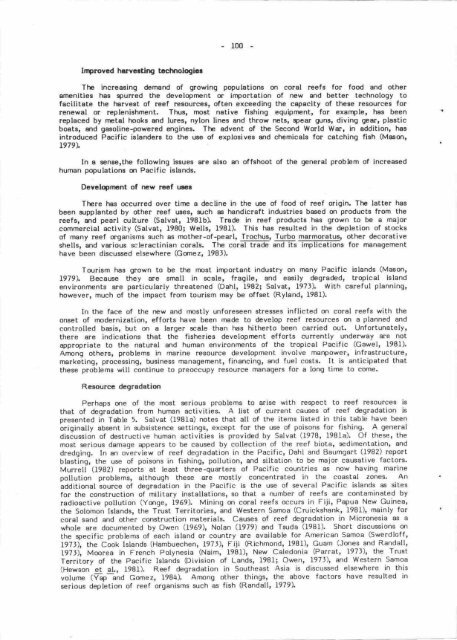Rt€@lll
Rt€@lll
Rt€@lll
Create successful ePaper yourself
Turn your PDF publications into a flip-book with our unique Google optimized e-Paper software.
Irprcvcd hervcrtlng tcctnologicr<br />
- I00<br />
TfE increasing demand of gnowing populations on coral reef s for food and other<br />
amenities has spurred the developnnnt or inportation of new and better technology to<br />
facilitate the harveet of neef nesources, often exceeding the capecity of thege regources for<br />
renewal or replenishment. Thus, rnoat native fishing equiprnant, for exanple, has been<br />
replaced by nntal hooks and lures, nylon lines and throw nets, spear guns, diving gear, plastic<br />
boats, and gasoline-powered engines. The advent of the Second World War, in addition, has<br />
introduced Pecific islenders to the use of explosives and chemicals for catching fiah (Mason,<br />
L979\<br />
In e senserthe following issues are also an offshoot of the general problem of increased<br />
human populations m Pacific islands.<br />
Devalqmnt of ncw rucf urer<br />
There hes ccurred over time a decline in the use of food of reef origin. The latter has<br />
been supplanled by other reef uses, urch as handicraft industries bssed on products from the<br />
reefs, md pearl c,ulture (Salvat, I98lb! Trade in reef products has grown to be a major<br />
commereial activity (Salvat, 1980; WeUs, 1981). This has resulted in ihe depletion of stocks<br />
of many reef organisms such as mother-of-pearl, Trochus, Turbo mermoratus, other decorative<br />
shells, and verious scleractinian eorals. The coral trade and its implications for management<br />
have been discussed elsewhere (Ganez, f98l).<br />
Tourism has grown to be ihe most important industry on many Pacific islands (Mason,<br />
L979). Because they are small in scale, fragile, and easily degraded, tropical island<br />
environments are particularly threatened (Dahl, 1982; Salvat, L97t). With careful planning'<br />
however, much of the impact from tourism may be offset (Ryland' f98l).<br />
In the face of the new and mostly unforeseen stresses inflicted on conal reefs with the<br />
onset of modernization, efforts have been made to develop reef resources on a planned and<br />
controlled basis, but on a larger scale then has hi[herto been carried out, Unfortunatelyt<br />
there are indications that the fishenies developnnnt efforts currently underway are not<br />
eppropriate to the natural and human environments of the tropical Pacific (Gawel' f98I).<br />
Among others, problems in marine resource development involve manpower, infrastrucluret<br />
marketing, processing, hrsiness management, financing, and fuel eosts. It is anticipaled !hat<br />
these problems will continue to preoccupy resource managers for a long time t.o come.<br />
Reaourcc degradation<br />
Perhaps me of the most serious problems to arise wilh respect to reef resources is<br />
that of degradation from human activities. A list of current causes of reef degradation is<br />
presented in Table 5. Salvat (l98la) notes that all of the items listed in this lable have been<br />
originally absent in subsistence settings, except for lhe use of poisons for fishing. A general<br />
discussion of destructive human acLivities is provided by Salvat (1978' l98la). Of these' the<br />
most serious damage appears to be caused by collection of the reef biota, sedimentation, and<br />
dredging. In an overview of reef degradation in the Pacific, Dahl and Baumgart (f982) repoct<br />
blasting, the use of poisons in fishing, pollution, and siltation to be major eausative fac[ors.<br />
Murrell (1982) reports at least three-quarters of Pacific countries as now having manine<br />
pollution problems, although these are mostly concentrated in the coastal zones. An<br />
additional source of degradation in the Pacif ic is the use of several Pacific islands as sites<br />
for the construction of military installations, so that a number of reefs are contaminaLed by<br />
radioactive pollution (Ymge, 1969). Mining on coral reefs occurs in Fiji, Papua New Guinea,<br />
the Solomon Islands, the Trust Territories, and Western Samoa (Cruickshank' I98I)' mainly for<br />
coral sand and other construction malerials. Causes of reef degradation in Micronesia as a<br />
whole are documented by Owen (1969), Nolan (1979) and Tsuda (I98f). Short. discussions on<br />
the specific problems of each island or country are available for American Samoa (Swerdloff'<br />
IgTt), the Cook Islands (Hambuechen, I97t), Fiji (Richmond, l98l), Guam (Jones and Randall'<br />
l97t), Moorea in French Polynesia (Naim, I98I), New Caledonia (Parrat, I97t), the Trust<br />
Territory of the Pacific Islands (Division of Lands, I98I; Owen, I97J), and Westenn Samoa<br />
(Hewson et {.r I9SI). Reef degnadation in Southeast Asia is diseussed elsewhere in this<br />
volume (Y-ap-and Gomez, 1984). Annng other things, the above factors have resulted in<br />
serious depletion of reef organisms zuch as fish (Randall, 1979).














![R]€@lll](https://img.yumpu.com/7594335/1/175x260/reurlll.jpg?quality=85)
